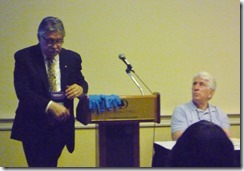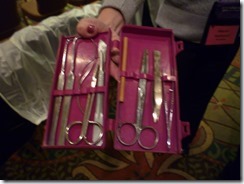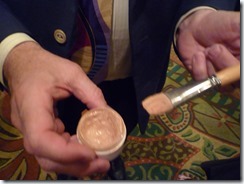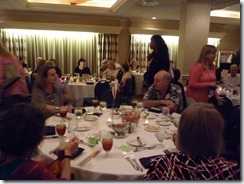SleuthFest Thursday, February 26, 2015
Thursday at SleuthFest is a day of special workshops. I got there after lunch and ended up at The Art of Embalming talk by George Rafaidus from Ford Funeral Home in Michigan. Attendees were treated to slides and descriptions of the embalming process, plus other behind-the-scenes details of how funeral homes prepare bodies. While it was a morbid topic, it was also a fascinating one. We received many handouts along with a show-and-tell of various props.
The Art of Embalming
Disclaimer: These notes are based on my interpretations. Any errors are unintentional and are mine alone.
Bodies are refrigerated from hospitals but not nursing homes. There’s more than one type of autopsy. There’s a partial wherein the thoracic cage is carved in the classic “Y” or there’s a cranial, like for Alzheimer’s patients or for medical studies. And then there is the double or complete autopsy. There may still be slight rigor mortis after 48 hours but that’s generally how long it lasts. Through washing of the body and manipulation, the stiffness lessens. The morticians need to know injection and IV sites, medical waste issues, birthmarks, and more, about the deceased. A trocar is a tool used to release gases and fluids from the body in the belly button area. Morticians shave people so they’ll look better for relatives.
How does the embalming work? They make an incision in the carotid artery, bring up the artery and inject embalming fluid. This part is done by machine. Up to 3 gallons of a formaldehyde and water mixture are injected in through the carotid and out through the jugular. This may take a couple of hours. The blood that is replaced goes through a filtration process before it’s released.
A dye in the fluid helps give the person a more natural complexion. Cosmetic enhancements may include a tissue fluid that works like Botox to fill in areas under the skin, so if the victim is emaciated or ill, they’ll look better for viewings. They may prepare the face with eye caps and mouth-formers. Look in the upper right corner of this photo to see these items.
If the person is being cremated, they could still have a visitation and viewing prior to the cremation. They could have a memorial service and embalming as well. Even if it’s a closed casket funeral, they would do the same, because a relative has to come in to identify the deceased. Difficult cases are trauma or accident victims. Regarding cosmetics, normal cosmetics have bluing agents that may distort a person’s color. So they use special makeup that’s like a foundation and brush it on the skin. (It’s sort of gummy and has an unpleasant odor—we tried it on). Waxes may also be used.
The state may dictate when embalming has to take place. Usually it’s at 48 hours. Embalmers are licensed. There are 38 mortuary schools throughout the country. A vault holds the casket to protect the body from the elements. The casket is labeled with the deceased person’s name, its burial location in the cemetery, and the name of the funeral home. In cases of flooding, this helps to identify the casket and where it belongs.
After the lectures finished, we were welcomed to Sleuthfest by Conference Co-Chairs Joanne Sinchuk and Vicki Landis.
Then publisher Neil Nyren spoke on Myths and Truths About Publishing.
Sleuthfest 101 Dinner followed, where we got to meet and mingle over a meal.
Coming Next: The agents and editors panels
View my SleuthFest 2015 photo album at https://www.facebook.com/NancyJCohenAuthor and Like my page while you’re there.






